Modern gas equipment, as a rule, can be fully automated. Thanks to the components for monitoring the safe operation of the equipment built into the structure, the reliability of the system as a whole is ensured. One of these devices is a gas boiler draft sensor.
Agree that it is quite convenient to use equipment that does not require the constant presence of a person. But on what principle does the thrust sensor work and is it so reliable?
We will consider these questions in our publication - we will talk about the device of the thrust sensor, its functionality and the features of the performance check. We will supplement the presented material with thematic photos and video materials.
The content of the article:
-
Sensor design and principle of operation
- Devices for natural draft boilers
- Turbine boiler sensor designs
-
How to check the functionality of the sensor?
- Stage # 1 - Performing a check of the control sensors
- Stage # 2 - checking the boiler pressure switch
- Stage # 3 - identifying the cause of the decrease in thrust
- Stage # 4 - Re-Testing Traction
- Possible reasons for sensor triggering
- Conclusions and useful video on the topic
Sensor design and principle of operation
Considering the variety of versions of gas boilers, it should be noted that traction control sensors are also found in different designs. If we consider their design in an extremely generalized way, we will talk about a fairly simple mechanism of devices.
The basis of almost any sensor for traction control of a gas boiler is a bimetallic element that changes shape when the temperature background changes. In fact, it is a simple bimetallic plate that bends when heated or cooled.
By changing the shape of the plate, the contact group is controlled, which transfers the state of the contacts to "Included" or "turned off". The switching signal of the contact group is transmitted to the gas boiler controller or to a simpler gas control mechanism.
The type of sensor that monitors the draft in the flue gas duct depends on the boiler used.
So, there are two types of gas boilers and are used in practice:
- Constructions equipped with a simple chimney (natural draft).
- Constructions equipped with a chimney with a turbine (with forced draft).
These designs differ from one another and the thrust sensors used for them also differ.
Devices for natural draft boilers
Natural draft boilers use a so-called flue gas hood, in which a simple miniature thermostat is built into the body, as shown in the picture below.
A thermostat of a simple design in a miniature version is usually endowed with a corresponding temperature mark directly on the body (on a metal shell). This mark (for example, 75º) indicates temperature limit of contact group actuation sensor.
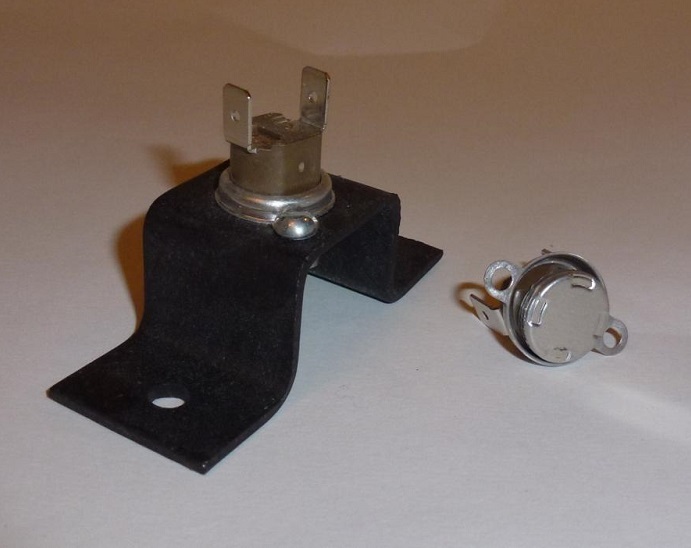
A thermostatic device of this type is installed, as a rule, as part of the structures of hinged gas boilers, where a flue gas hood built into the chimney line is used.
The operation of such a device is simple. If the flue gases passing through the hood with the installed sensor heat the device above the set temperature parameter (which indicates a violation of the draft mode), the contacts are open.
Accordingly, due to an open circuit, the gas supply system to the boiler will be shut down (blocked). The equipment will restart only after the sensor has cooled down and the open contact has been restored.
Turbine boiler sensor designs
Boilers equipped with a chimney with a turbine have a slightly different sensor for detecting the draft of a gas boiler with a different operating principle. First of all, the difference is that the sensor actually controls the boiler turbine fan. In other words, the optimal flue gas draft is controlled by the fan.
That is why the device of the draft sensors of turbine gas boilers is made not under temperature control, but under control of the volume of passing carbon monoxide.
Such sensors work on the fact that there is an optimal vacuum inside the combustion chamber, they have a contact group of three elements:
- contact COM;
- normally open (NO);
- normally closed (NC).
Structurally, the devices are made different in shape, but their principle of operation remains unchanged. Upon the formation of operating conditions inside the gas boiler chamber (optimal vacuum), the supplied air pressure closes the contact group, sending a signal for gas supply.
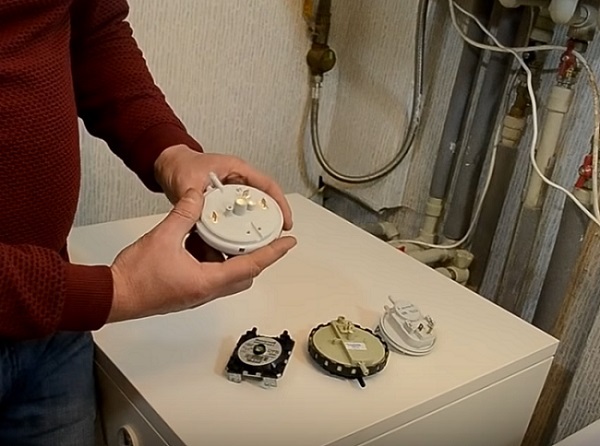
A slightly different type of sensor elements designed to control the draft in the boiler - designs whose principle of operation is based on the pressure difference of the outgoing flow
How to check the functionality of the sensor?
Disruptions to the traction of a gas boiler are often compared with sensors. In any case, many craftsmen traditionally point to a malfunction of the traction sensor.
It is quite simple to check how the draft sensor works on a household gas boiler. It should be noted that periodic inspection of such structural components is, in fact, commonplace. Especially for boilers equipped with a fan.
Stage # 1 - Performing a check of the control sensors
Almost every equipment with a fan has special test points, using which the sensor is tested.
Test points (nipples) are usually located in chimney area (upper part of the boiler). An example of the arrangement of such elements is shown in the picture below. Both fittings are marked accordingly. That is - have the designations "+" and "-", indicating the flow path.

Test points (fittings) for measuring the vacuum level inside the combustion chamber of the boiler. These elements are used for control measurements using a special pressure gauge
Next to the test connections, there is usually another test interface (on the left, closed with a lid), through which it is permissible to measure the temperature of gases and the efficiency of the equipment.
The order of taking measurements is as follows:
- Unscrew the protective caps on the fittings.
- Connect the manometer tubes to the fittings.
- Observe the accuracy of the connection at the points "+" and "-".
- Switch on the "Chimney sweep" mode on the boiler.
- Wait until the equipment reaches maximum work.
After the equipment reaches maximum power, check the pressure gauge readings. The device should show admissible vacuum levelthat does not go beyond the established range for a specific brand of gas boiler. Refer to the hardware documentation for the required range.

Performing test measurements of the vacuum level inside the combustion chamber of a gas boiler using a digital gauge functionality
The procedure demonstrating how to check the draft sensor on a household gas water heater, in addition to measuring with a pressure gauge, also includes one more necessary action - checking the boiler pressure switch.
The fan of a gas boiler is traditionally equipped with a device called a pressure switch. Thanks to this device, fan control and actual burner control gas boiler.
The pressure switch is connected to the air duct with rubber tubes. However, to check this element of the circuit, you will have to open the body of the gas boiler.
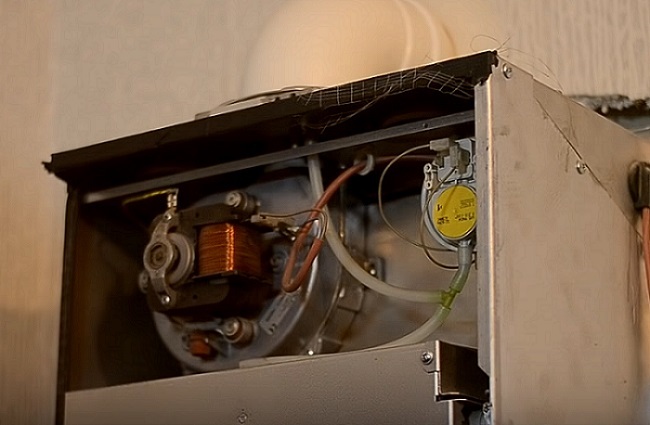
Two important devices are located inside the body of the gas boiler - the turbine fan plus the pressure switch control device
The principle of operation of this technical pair is quite simple. From the air channel through a rubber tube, the pressure (negative relative to the pressure in the second tube) is taken by a pressure switch.
If the pressure selection is normal, the pressure switch contact circuit is closed - the gas boiler is functioning normally. In the event of a change (deviation) in the vacuum level, the pressure difference changes, which leads to a rupture of the contact group of the pressure switch. Accordingly, the equipment is taken out of service (boiler shutdown).
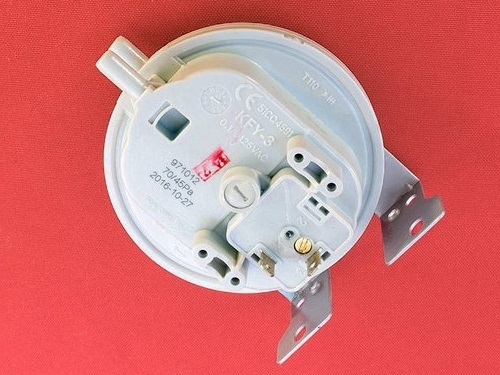
The device for monitoring the operation of the fan - a pressure switch, has a label on the body of the technical parameters - the boundary pressures for turning on and off the gas burner
Any branded pressure switch always has the designation of operating parameters on the body part. In particular, the parameter of the trigger pressure of the device for switching on and off is indicated (for example, for the pressure switch shown in the photo above, it is 70/45 Pa). In other words: in this case, the gas burner operates at a pressure of 70 Pa and is blocked at a pressure of 45 Pa.
Stage # 2 - checking the boiler pressure switch
To check the pressure switch, you need to perform a simple action - to determine the quality of the electrical circuit of the device. The switching element of the pressure switch is a conventional microswitchbuilt into the structure of the device.
The microswitch is controlled (contacts close or open) by a plate, which is influenced by the force of air pressure entering the device through the tubes.
The contacts of the microswitch are brought out to the outer side of the device case. Accordingly, for testing, you need to connect a measuring device (multimeter) configured to measure resistance Ohm to the contact group.
Each branded device is equipped with an electrical circuit indicated on the case. In accordance with this diagram, the probes of the multimeter and the contacts of the device are connected.

Testing the integrity of the gas boiler pressure switch using a standard electronic (electrician) tool - a multimeter. Checking the continuity of the microswitch circuit
After connecting the probes of the multimeter, a piece of silicone tube is connected to the negative pressure channel of the pressure switch. Through the connected tube, negative pressure is created on the device (simply by sucking in air with the mouth) and at the same time the readings of the multimeter are monitored.
With normal switching, the arrow of the device will show the minimum resistance or not react at all, depending on the pressure created in the tube. If the microswitch is faulty (the commutation channel is broken), the multimeter will not show any reaction. In this case, the pressure switch must be replaced with a new one.
We recommend that you familiarize yourself with the intricacies of inspection and maintenance of gas boilers.
Stage # 3 - identifying the cause of the decrease in thrust
The reason for the decrease in thrust is not always a sensor breakdown.
So, practice shows that insufficient traction can be caused by many other factors:
- clogged air transfer tubes;
- clogging of the inner area of the fan volute;
- the formation of condensation inside the silicone tubes;
- ingress of foreign objects into the tubes.
One of the common reasons for a decrease in boiler draft is often the clogging of the inner area of the fan volute. Cleaning this area restores full traction.
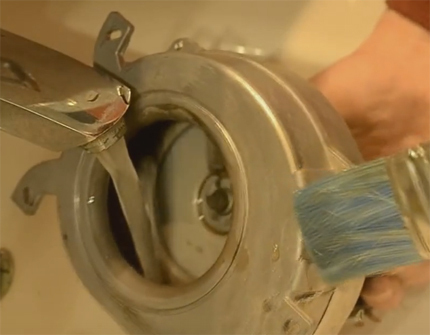
Cleaning the inside of the gas boiler fan volute helps to restore the draft to its previous level. Maintenance requires a little water and a soft brush
After prolonged operation of the gas boiler, a large amount of dust and fumes is collected on the fan impeller blades and the walls of the volute. Over time, these deposits become compacted, become rigid and as a result create significant resistance to air flow. This is one of the most common reasons for the boiler loss of draft.
The boiler fan will of course have to be dismantled before cleaning the interior. Most boiler designs provide for easy dismantling / mounting of the fan. Usually, it is enough to remove two or three mounting screws to disconnect the component from the chassis. Disconnect the gas boiler from the power supply beforehand.

Here, approximately, this is the state of the gas boiler fan should be during the operation of the equipment in order to ensure the optimal draft of flue gases
Flushing with water should be carried out in such a way that moisture does not get on the stator winding of the electric motor and other electrical components. The best option seems to be cleaning by blowing compressed air into the interior of the volute and blades. True, at home, this option is often impossible.
We have provided recommendations for cleaning and self-service of the gas water heater in next article.
Stage # 4 - Re-Testing Traction
After completing the procedure for cleaning the gas boiler turbine fan and installing this component construction to your workplace, the equipment will have to be tested for traction level again flue gases.
That is, again, the operation described above should be performed - checking the vacuum level inside the combustion chamber. The previously disassembled body of the gas boiler must be reinstalled - bring the boiler into full working condition.
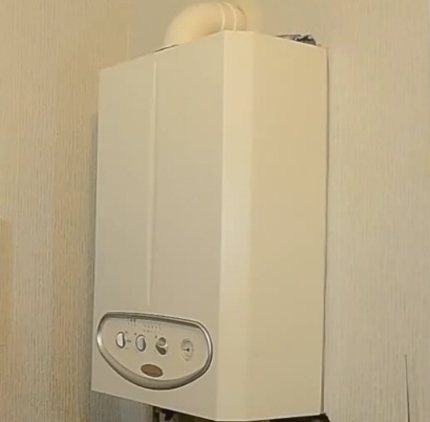
The assembled gas boiler is a prerequisite before testing the equipment for the vacuum level inside the combustion chamber, since an open casing disrupts the normal operation of the turbine
As a rule, the test results show a slight increase in the pressure gauge readings, which indicates the normal operating condition of the flue gas outlet. Taking into account this practice, it can be concluded that it is not always the temperature sensor or pressure switch that is the primary reason for the violation of the traction mode of a gas boiler.
Therefore, initially you need to check all the equipment and accessories involved in the smoke channel scheme. Indeed, in this case, the problem was in the clogging of the turbine fan of the gas boiler.
Possible reasons for sensor triggering
Often, the frequent actuation of the gas boiler draft sensor is observed immediately after the installation of new equipment and subsequent commissioning.
Boiler malfunctions with this option are usually caused by:
- incorrect channel construction scheme smoke removal;
- extraordinary weather conditions in the region;
- violation of the traction characteristics of the equipment;
- incorrect setting of the control controller.
In regions where strong winds prevail, the reason for the sensor triggering may be trivial - wind entering the flue gas discharge channel. For such cases, it is recommended to additionally install on the pipe traction stabilizer.
The traction characteristics were noted above, and specialists should be involved in setting up the geyser controller.
Conclusions and useful video on the topic
The video describes the structural details of the thrust sensors, the location of these components and their principle of operation:
If professional craftsmen are familiar enough with gas equipment, for the average user troubleshooting a gas boiler is a "dark forest". In addition, dealing with gas systems in the absence of appropriate knowledge has serious consequences.
Therefore, when there is a desire to independently replace or repair the same traction sensor or some other equipment of the gas water heater, you first need to at least study the system. But the best way to eliminate defects in the gas system is to contact a specialist.
Would you like to supplement the above material with helpful notes on how the thrust sensor works? Or would you like to share your sensor verification experience with other users? Write your remarks and comments in the block below, add unique photos of your own testing.


